Six Takeaways from Indore’s New Air Quality Monitoring Stations
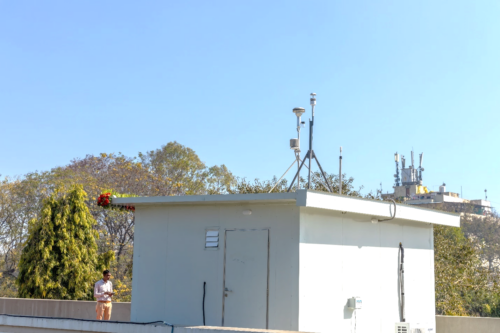
Research around the world shows that pollution levels can vary enormously within the same city and even within the same neighborhood. Local monitoring data can thus prove essential to understanding air pollution sources, how they affect different communities and groups, and where to target policy solutions. That’s why Clean Air Catalyst launched three air quality monitoring stations in Indore in January 2023. These new stations have significantly improved the city’s air quality tracking capabilities in some important ways:
- Nearly doubling the total number of monitoring stations that were operational in the city prior to January, taking the total number from four to seven.
- Covering new areas—including lower-income neighborhoods—where air quality monitoring was not previously available.
- Measuring air quality on a continuous basis. Most of the preexisting stations in Indore collected data less frequently.
- Enhancing the city’s ability to monitor meteorological trends that impact air quality, such as wind direction and speed, temperature, relative humidity, and barometric pressure.
- Expanding coverage of lesser-known pollutants, especially black carbon, which was not tracked by all preexisting monitoring stations.
Publicly available air quality data is an essential first step toward cleaner air and better health. These new capabilities are equipping Indore’s leaders and residents to reveal this largely invisible threat like never before.
The Catalyst published a report earlier this year analyzing the 2023 data collected by its three new stations*, in addition to data from a fourth continuous monitoring station set up by the Madhya Pradesh Pollution Control Board in 2019. In this blog, we break down six of the most fascinating insights found in the report—and what they can tell us about ways to alleviate Indore’s air pollution.
Insight 1: The new stations brought air quality monitoring to parts of Indore that lacked it before
Indore’s air quality monitoring capacity grew significantly in 2023
Pre-existing and new air quality monitoring stations (added in 2022-23)
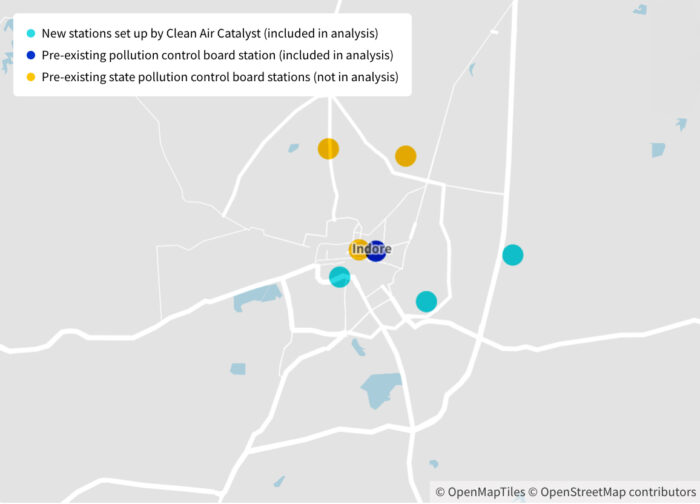
What we found: Prior to the arrival of the three new monitors installed by the Catalyst (shown on the map in light blue), four state-run air quality monitoring stations were present in Indore. The newest of those, the continuous station (shown as a dark blue dot) which is included in the Catalyst analysis, was set up in late 2019. As the map above shows, the state-run stations (yellow and dark blue) are concentrated in Indore’s urban center and in peri-urban communities to the north.
Why it matters: While the preexisting stations formed a critical foundation of monitoring capacity, they left many communities—particularly densely populated areas to the south and east—without monitoring. The new stations go a long way toward filling those gaps. In choosing where to locate the new stations, city leaders, with support from the Catalyst, prioritized not only geographic diversity, but also diversity of neighborhoods by income and urbanization level. With these considerations in mind, they placed one station in an urban site, one in a peri-urban site, and one in a low-income residential site. These siting choices reflect a core value: to focus on previously overlooked groups.
Insight 2: Fine particulate air pollution levels surpassed national standards for most of 2023
Daily air pollution levels in Indore exceeded safety limits for much of 2023
Monthly % days where PM2.5 levels exceeded India’s daily standards (24 hr avg. standard 60 micrograms/m3) at each monitoring station site
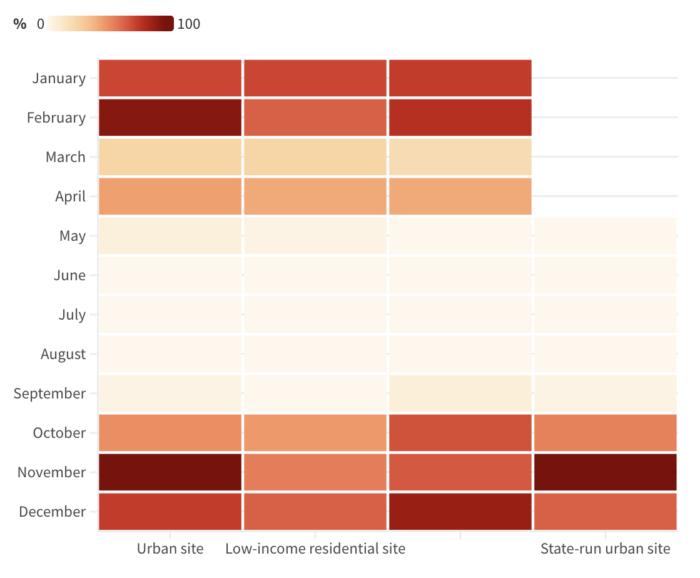
What we found:
- The Catalyst’s analysis found that average monthly levels of fine particulate air pollution (PM2.5) levels recorded by all four stations surpassed India’s national daily standard (60 micrograms/m3) for more than a third of days of 2023, as shown above.
- Monthly PM2.5 levels also far exceeded the World Health Organization’s more stringent 24-hour average guideline (15 micrograms/m3) for nearly all of 2023.
- Monthly average PM2.5 levels observed across all four stations ranged between 19 micrograms/m3 and 108 micrograms/m3, with the highest monthly average in November and the lowest in August.
- These results align with trends recorded by preexisting monitors and observed in other cities across the region.
Why it matters: Exposure to unsafe air pollution levels increases the risk of serious health conditions at all ages. Let’s break down these conditions by age group:
- For infants: Preterm birth and low birth weight among babies
- For young children: Stunting and development of asthma
- For adults: Stroke, heart and lung disease, diabetes, and cancer
- For older adults: Dementia, in addition to all the other risks to adults listed above
Air pollution also worsens health among those with existing diseases and disproportionately affects some groups that are more likely to be exposed, such as women and lower income residents. By taking action to reduce air pollution year-round, Indore’s leaders can significantly improve the health and safety of its residents.
Insight 3: Fine particulate matter was more than three-times higher in winter than in the monsoon season
Indore’s air pollution was highest in the winter and post-monsoon seasons
Average PM2.5 levels by season and station site, 2023
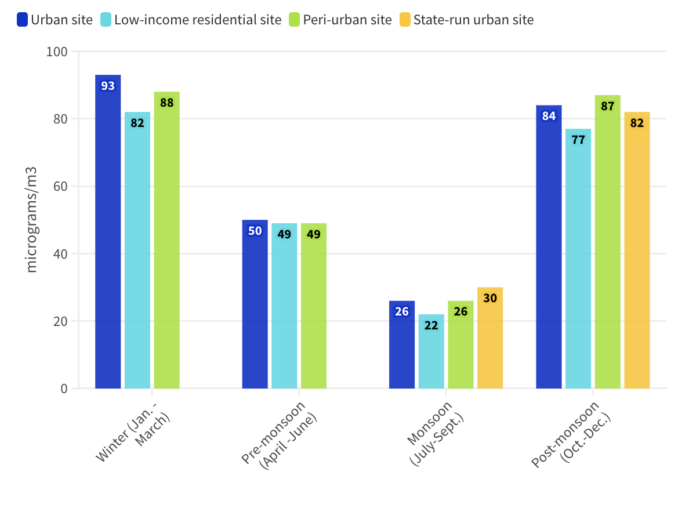
What we found:
- Across all four station sites, fine particulate matter levels were highest during the winter and post-monsoon seasons and lowest during the monsoon and pre-monsoon seasons.
- Seasonal average PM2.5 concentrations breached the 60 micrograms/m3 national daily health standard for about 80% of observed days during the winter and post-monsoon months and for about 20% of days during the summer months.
- During the monsoon season, the daily average PM2.5 levels were at their safest, with only one day surpassing the 60 micrograms/m3 standard.
Why it matters: Seasonal variations in air pollution are likely due to the combined effects of changing emissions and weather patterns. During colder seasons, residents burn more firewood, coal and other fuel sources to stay warm, driving up local emissions. Meanwhile reduced wind and rain in those seasons result in pollution being less likely to disperse quickly, thus allowing it to become more concentrated. Understanding these seasonal trends will help the city target solutions during seasons when air pollution is highest and at specific sources.
Insight 4: Air pollution was highest in the morning and evening hours, likely due to traffic surges
Daily air pollution highest in mornings and evenings, especially at more densely populated sites
Average PM2.5 levels over 24-hours by station site, 2023
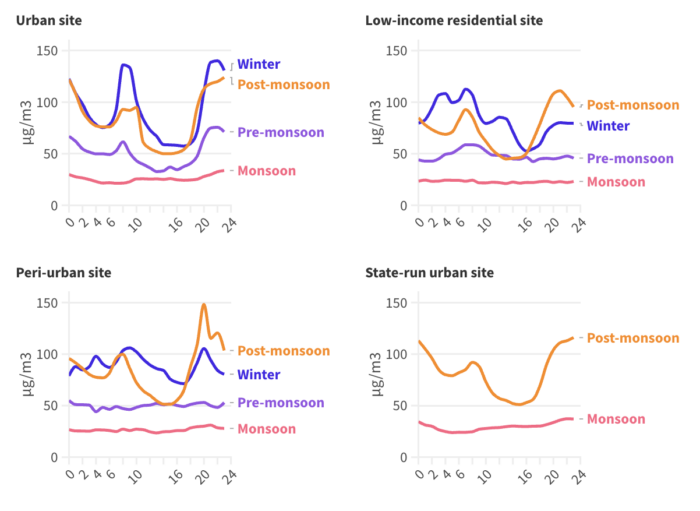
What we found:
- For most of the year, most monitoring stations detected significant spikes in fine particulate levels in the morning hours peaking around 8:00 AM, and in the evening hours peaking around 8:00 PM.
- Following the previous insight about seasonal variation, these spikes were consistently highest during the winter and post-monsoon seasons and almost non-existent in the monsoon season. They were more pronounced at the urban and peri-urban sites, which were likely to experience heavy traffic congestion at these rush-hour times.
Why it matters: These time-of-day trends suggest that the transportation sector is likely a chief contributor to Indore’s air pollution. They underscore the potential importance of policies that can help alleviate congestion and vehicular emissions, such as low-emission zones, expansion of public transportation, and expediting the city’s transition to electric vehicles.
Insight 5: Air pollution levels in Indore varied significantly depending on wind speed
Higher air pollution associated with lower wind speeds in Indore
Average PM2.5 levels by wind speed at low-income residential site, 2023
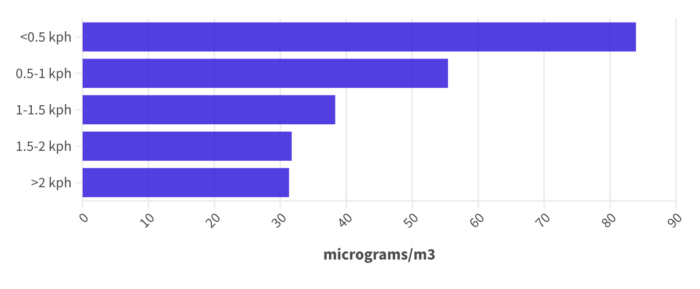
What we found:
- All four stations observed clear patterns in PM2.5 levels at varying wind speeds, measured in kilometers per hour.
- At the low-income residential site for example, PM2.5 levels were consistently higher during slower wind speeds, as depicted in the graphic above.
Why it matters: Because air pollution—especially from local sources like transportation—is continuously emitted, wind can play an important role in dispersing pollutants and keeping them from accumulating in the air. In times when winds are lower, air pollution tends to disperse more slowly, which can drive up PM2.5 levels. Wind can also play a role in transporting external air pollution into and out of the city—a phenomenon we hope to explore in a future data story blog post. These insights, along with others on seasonal and time-of-day trends, can help residents make informed decisions about when to stay indoors.
Insight 6: Carbon monoxide levels in Indore’s busiest areas were also at their highest during winter and post-monsoon seasons, at times breaching safety limits
Carbon monoxide levels surged in the winter and post-monsoon seasons
Average carbon monoxide concentrations over 24-hour day for urban site
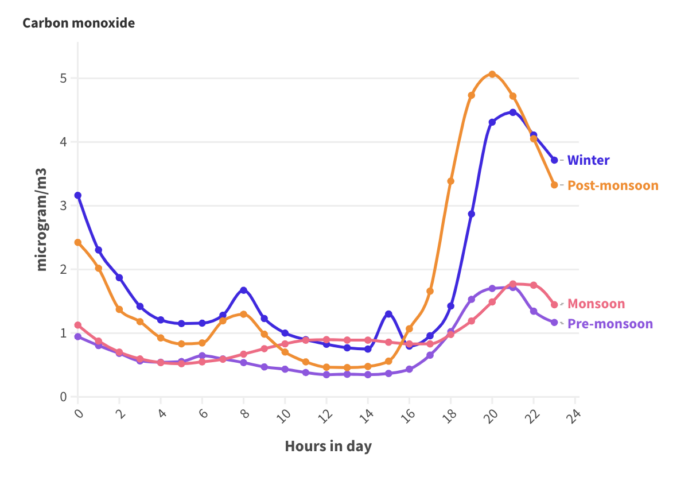
What we found: One of the new stations, the urban site, was equipped with instruments that measure concentrations of black carbon (BC) and carbon monoxide (CO), two other pollutants commonly released during the burning of fossil fuels. These pollutants are linked to many of the same health impacts as PM2.5 but have received less attention. Here’s what the data from that station reveled so far:
- As the graphic above illustrates, the station observed similar seasonal and hourly trends for CO as it did for PM2.5, with concentrations soaring during the winter and post-monsoon months.
- CO levels even breached national safety standards (4 mg/m³ for one hour of exposure) in the evening hours during those higher-risk seasons, likely due to elevated vehicular activity.
- While the urban site station collected data on CO concentrations for more than 95% of 2023, it was unable to collect consistent BC data due to instrument issues. We hope to examine BC in a future blog post after more data becomes available.
Why it matters: These revelations underscore the many layers of exposure risk brought on by transport-related pollution, particularly in Indore’s busiest streets. Better access to data on CO and BC can help city and state officials capture a more complete picture of the range of pollutants that threaten the health of residents.
Next steps: From data to insights to action
These new data and insights represent a powerful tool for Indore’s policymakers. They can help the city craft interventions that deliver greater air quality improvements per dollar spent, target major sources with greater precision, and prioritize most-affected groups such as women and low-income residents. City leaders are committed to continue expanding monitoring coverage as well, having brought four additional continuous monitoring stations online since the start of 2024.
The data showcased here, along with insights from other Catalyst research that we’ll explore in upcoming data stories, form a solid basis for informed clean air action. Moving ahead, the Catalyst will continue aiding Indore on its journey towards cleaner, healthier air by supporting the continued expansion of monitoring, offering transparent analysis, and collaborating with cross-sector leaders to design solutions.
This blog post is part of a data story series exploring air quality in Indore. Look out for more data stories later in 2024. Clean Air Catalyst is a flagship program launched by the U.S. Agency for International Development and a global partnership of organizations led by World Resources Institute and Environmental Defense Fund, Inc. We are focused on building capacity for locally tailored solutions that curb air pollution, tackle climate change and improve human health.
*Note that the insights shared here are based on preliminary data that may be subject to revision.
This blog was originally posted on the Clean Air Catalyst website.
All charts were produced with Flourish and can be interacted with on the original post linked above.

